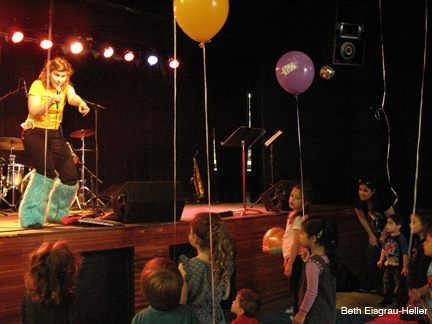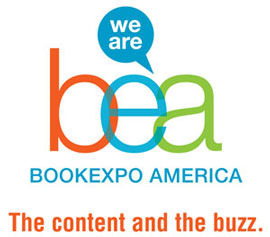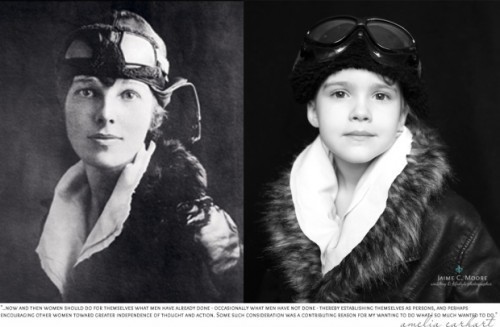Betsy Bird's Blog, page 312
May 28, 2013
Review of the Day – Native Americans: A Visual Exploration by S.N. Paleja
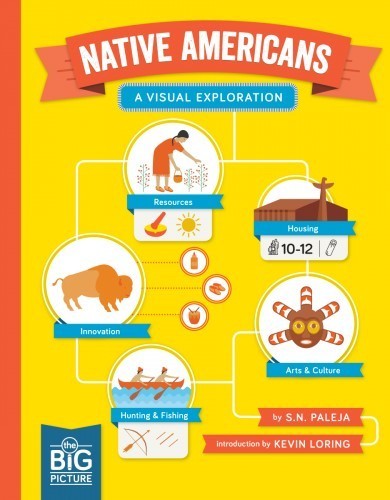 Native Americans: A Visual Exploration
Native Americans: A Visual Exploration
By S.N. Paleja
Intro by Kevin Loring
Annick Press
$19.95
ISBN: 978-1-55451-485-4
Ages 9-12
On shelves now
Nonfiction trends in children’s literature are oddities. For all that children make up such a large swath of the American population, relatively few people specialize solely in creating works of nonfiction for them in a variety of different, potentially pleasing, ways. That said, when you look at enough of it over the course of a given season, a pattern starts to emerge. And as of right now as I write this review in 2013 the hottest new trend in nonfiction works for the young is the incorporation of infographics into books that would otherwise be considered just a sneeze shy of textbooks in terms of interest. Suddenly topics that previously bored to tears are now awash in colors and funky forms. True, it’s all still stats and facts, albeit made slightly more visually stimulating, but there’s something to be said for that. What I didn’t see coming was the application of this form to the topic of Native Americans. Probably one of the most popular topics a children’s librarian faces on a regular basis, very little concrete, inoffensive, and contemporary information exists for children. S.N. Peleja seeks to change all that and the end result is a book that has its flaws but after much consideration may ultimately be the best thing out on the market today.
“Native American people are as different as the land they come from.” So begins Kevin Loring, winner of the 2009 Canadian Governor General’s Literary Award for Drama and a member of the Nlaka’Pamux First Nation in British Columbia. As he explains, the topic of this book is gigantic, so the author has touched on many basic aspects of Native American lives in order to inspire further reading. Using every graph, chart, word cloud, and statistic available, author/illustrator S.N. Paleja delves into Origins, Tribes and Society, Plants and Animals, Culture, Making Contact, and Modern Day topics chapter by chapter. We look at the wide variety of housing depending on climates and needs, place names we use today, the top languages as of 2012 (Navajo is king), sports, population shifts and much much more. In closing Paleja includes a Selected Bibliography of up-to-date sources, a section of Further Reading for young eyes, and an Index.
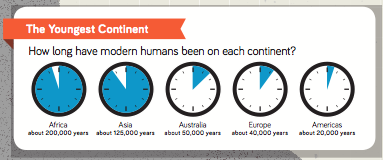 So here’s the downside of infographics in books for kids: Kids don’t care about infographics. Adults care about infographics. Show an adult (or even a teen ala The Fault in Our Stars) a Venn Diagram and watch as their pulse quickens. Now show that same image to a kiddo and to them it’s a circle overlaid over another circle and . . . . yeah. That’s what that is. Pleasure reading for the youngsters, this is not. That said, this isn’t really meant to be a pleasure reading book anyway. It’s a book of facts, presented in a visually stimulating format, ideal for homework assignments. The Index at the end will allow kids to latch onto specific tribes, terms, concepts, and historical moments as well. Few will be the reader that goes through the book start to finish.
So here’s the downside of infographics in books for kids: Kids don’t care about infographics. Adults care about infographics. Show an adult (or even a teen ala The Fault in Our Stars) a Venn Diagram and watch as their pulse quickens. Now show that same image to a kiddo and to them it’s a circle overlaid over another circle and . . . . yeah. That’s what that is. Pleasure reading for the youngsters, this is not. That said, this isn’t really meant to be a pleasure reading book anyway. It’s a book of facts, presented in a visually stimulating format, ideal for homework assignments. The Index at the end will allow kids to latch onto specific tribes, terms, concepts, and historical moments as well. Few will be the reader that goes through the book start to finish.
Any time a children’s librarian sees that a new book about Native Americans / American Indians is on the market the wariness factor starts to rise. Talk about difficult subject matter. On the one hand, librarians are inundated with requests from children, teachers, and parents for more books on specific Native tribes and histories because that’s what the schools are demanding. It’s an important piece of history. On the other hand, we have to be incredibly wary and cautious going forward of any new material on those subjects. Misinformation is rampant, as is the general feeling from these books that this is a race of people that died out long ago. So to counter all of this with, of all bizarre notions, a factual all-encompassing title utilizing infographics . . . well, it’s at the very least worth a look.
To reassure gatekeepers like myself the book is prefaced by Kevin Loring, a member of the Nlaka’Pamux First Nation. In this introduction Loring specifies that this is just a snapshot of various aspects of Native American life. Then he discusses the term “Native American” in the first place and explains that there were many sources where this information was culled (indeed the Bibliography at the back is extensive for a book for 9-12 year-olds). In what might be considered a stretch by some, Loring then links the infographic style to the pictograph tradition of some tribes. Certainly I’ve seen that style of illustration used in books by Paul Goble and S.D. Nelson but here it just feels convenient, more than anything else.
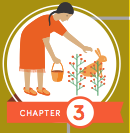 As it stands, the biggest problem with the book is the very basis behind it. Infographics work best when you deal with generalities rather than specifics. And while Loring has confronted this problem head on, that doesn’t necessarily mean it’s not still an issue. You might argue, and argue well, that any book about any person using infographics is going to reduce those people into numbers. Native Americans, unfortunately, have had that very act done to them for centuries. Then there are the visuals. In the Plants and Animals chapter the rote Native Americans pictured there are meant to symbolize tribes like the Hopi, Navajo, and Cherokee, and so the image of the woman is just in a standard dress, not distinguished in any way. It’s a tricky line to walk. The text is, for the most part, factual though there are moments that give one serious pause. It was a Kirkus review that pointed out that the hugely problematic sentence, “Generosity is an important aspect of Native American spirituality” is shockingly broad. Likewise, there might be some question as to the wisdom of using symbols like a bound hand to represent kidnapping when explaining various European crimes. It’s good that this is acknowledged, but could be considered callous too. That said, there’s something particularly satisfying about seeing Christopher Columbus held accountable for these crimes. Many biographies of the man conveniently forget that part.
As it stands, the biggest problem with the book is the very basis behind it. Infographics work best when you deal with generalities rather than specifics. And while Loring has confronted this problem head on, that doesn’t necessarily mean it’s not still an issue. You might argue, and argue well, that any book about any person using infographics is going to reduce those people into numbers. Native Americans, unfortunately, have had that very act done to them for centuries. Then there are the visuals. In the Plants and Animals chapter the rote Native Americans pictured there are meant to symbolize tribes like the Hopi, Navajo, and Cherokee, and so the image of the woman is just in a standard dress, not distinguished in any way. It’s a tricky line to walk. The text is, for the most part, factual though there are moments that give one serious pause. It was a Kirkus review that pointed out that the hugely problematic sentence, “Generosity is an important aspect of Native American spirituality” is shockingly broad. Likewise, there might be some question as to the wisdom of using symbols like a bound hand to represent kidnapping when explaining various European crimes. It’s good that this is acknowledged, but could be considered callous too. That said, there’s something particularly satisfying about seeing Christopher Columbus held accountable for these crimes. Many biographies of the man conveniently forget that part.
Where the book shines brightest is when it gives an accounting of matters that are difficult to envision. Consider the old line that certain tribes would use “every part of the bison” in their everyday lives. How exactly does that work? Well, on the page “What can you make with a bison” the idea that you’re dealing with a “walking department store” suddenly makes perfect sense. Before you is an image of a bison with labels indicating body parts and what they could be reconstituted into. There’s the standard hide to blankets and bones to knives but then there’s also some of the lesser known qualities like hooves to glue, blood to paint, and sinew to sewing thread. In other parts of the book there’s also a satisfying account of when specific tribes came in contact with specific settlements from overseas. Everything from 1000 CE: Norse to the 1529 Spanish are distinctly specified and pointed out.
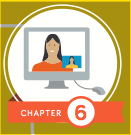 Another point in the book’s favor is the fact that contemporary statistics play a large part. As I mentioned before, glance through an average children’s library of Native American information and literature and you’re going to come away fairly convinced that there aren’t any tribes or people left. Name me three middle grade children’s works of fiction about contemporary American Indians. Can’t be done. So to see a kid’s book continually mentioning everything from the 18% increase in business ownership by Native Americans between 2002-2007 (as opposed to 9% for white Americans) or the growth in population between 2000-2010 (27% in the U.S. and 45% in Canada) is unprecedented. As the book is Canadian originally, it takes care to show not just where they live in the States but in places like Ontario or the four Western provinces as well.
Another point in the book’s favor is the fact that contemporary statistics play a large part. As I mentioned before, glance through an average children’s library of Native American information and literature and you’re going to come away fairly convinced that there aren’t any tribes or people left. Name me three middle grade children’s works of fiction about contemporary American Indians. Can’t be done. So to see a kid’s book continually mentioning everything from the 18% increase in business ownership by Native Americans between 2002-2007 (as opposed to 9% for white Americans) or the growth in population between 2000-2010 (27% in the U.S. and 45% in Canada) is unprecedented. As the book is Canadian originally, it takes care to show not just where they live in the States but in places like Ontario or the four Western provinces as well.
I don’t think it’s possible to make an infographic book of Native American statistics that is without its problems. The very nature of the idea itself is rife with difficulties, after all. Still, I look at other books that have covered the territory that Paleja has covered here, and I can’t help but find them lacking. Either their scope is too small (just looking at The United States / a section of the country / a moment in history, etc.) or they bore the reader to tears. Paleja in turn gives us a book that generalizes even as it specifies. It’s obviously not perfect, but it’s the best we’ve seen in a very long time and for that reason alone I think it’s notable. Worth looking at. Worth considering.
On shelves now.
Source: Review copy borrowed from co-worker.
Like This? Then Try:
Before Columbus: The Americas of 1491 by Charles C. Mann
The Children of Native America Today by Yvonne Wakim Dennis
Walking on Earth and Touching the Sky: Poetry and Prose by the Lakota Youth at Red Cloud Indian School, edited by Timothy P. McLaughlin
Other Blog Reviews:
Rebecca Reads
Duchess Kenni
Moon Shine Art Spot
Professional Reviews:
Kirkus
Misc:
Preview six pages of the book here.
May 26, 2013
Video Sunday: She’s not your wife. She’s the princess.
Can you think of a better way to kick off? Not I, said the fly. Yes, the world’s most confused woman (not me) is celebrating her 50th birthday. I am pleased to report that Harper Collins is allowing me to reveal this video today. The strange thing about Amelia B is that she seems to just get younger as she gets older. And naturally, I cannot go much further in this blog post before linking to my favorite Amelia Bedelia video of all time. An all boy cast reenacts Play Ball, Amelia Bedelia. I just love the star of the show.
And now, the heartfelt out-of-work librarian blues. A little too familiar to some, I’ll bet. Dead on with the “old ones are retiring” part. They told me that in library school too.
Thanks to AL Direct for the link.
Though I had heard the Jarrett Krosoczka / Jack Gantos story before, I don’t know that it was captured on film until this moment. Here’s a rather fabulous video that accompanied the NPR piece ‘Lunch Lady’ Author Helps Students Draw Their Own Heroes.
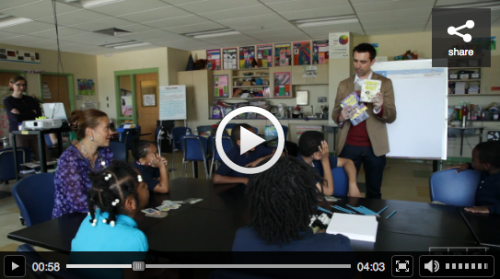
Thanks to Jeanne Birdsall for the link!
Finally, it’s a short week so let’s do our off-topic video. This one’s been making the rounds and it’s fairly self-explanatory. I look forward to more in the series.
May 24, 2013
Celebrate the Life of Peter Sieruta
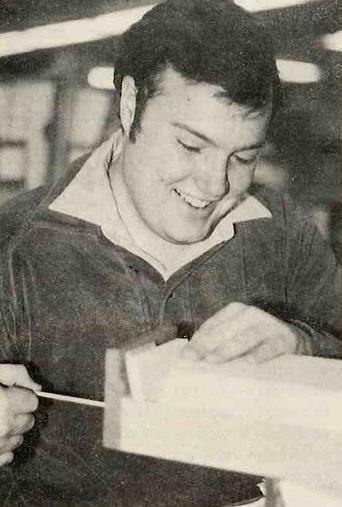
Celebrate the Life of One of Children’s Literature’s Luminaries:
A Peter Sieruta Event
Friday, June 28th, 4:30 p.m.
The Lake Erie Room at the Hilton Chicago
How did you best know Peter Sieruta? Was it through his remarkable blog Collecting Children’s Books (a go-to site for wit and historical tidbits)? Was it from his countless Horn Book articles or his work on the Horn Book Guide? Maybe you met Peter in a bookstore or you were a close personal friend. Whatever the case, come, mix, and mingle with other friends and fans of the often urbane, always scintillating fellow. This event will be held as a celebration of Peter and his book (co-written with Julie Danielson and Betsy Bird), Wild Things: Acts of Mischief in Children’s Literature slated to hit bookstore shelves in spring 2014.
Please RSVP to me at Fusenumber8@gmail.com if you would like to attend this gathering.

May 22, 2013
Show Me the Awesome: Children’s Librarians Can Do Anything
 If you traverse the interwebs on a regular basis then you may have spotted the catchy “Show Me the Awesome” posts that have been springing up hither and thither. Thither and yon. The initiative was started by Kelly Jensen, Sophie Brookover, and Liz Burns. Designer John LeMasney was, in turn, responsible for the kicky graphic you see here. And if you’re interested in viewing what goes on you can follow the posts on Twitter, Tumblr, Vine and Instagram with the hashtag #30awesome or you can head on over to Stacked to see a full roster of what has already taken place.
If you traverse the interwebs on a regular basis then you may have spotted the catchy “Show Me the Awesome” posts that have been springing up hither and thither. Thither and yon. The initiative was started by Kelly Jensen, Sophie Brookover, and Liz Burns. Designer John LeMasney was, in turn, responsible for the kicky graphic you see here. And if you’re interested in viewing what goes on you can follow the posts on Twitter, Tumblr, Vine and Instagram with the hashtag #30awesome or you can head on over to Stacked to see a full roster of what has already taken place.
So what precisely is going on here? Typically an on-the-ball blogger comes up with original content and presents ideas in a unique and fascinating way. The lazy blogger cuts and pastes. Which do you think I’m about to do? From Kelly Jensen’s post:
While we have a lineup of official people taking part in the series, anyone is welcome to blog on the topic of self promotion. You can talk about a program you did and loved. You can talk about how you perform strong reader’s advisory with teens. You can talk about the grander idea of self promotion itself. There’s nothing off limits, as long as you’re talking about libraries and self promotion or librarianship and self promotion in some capacity.
Librarians talking librarianship. And so far we’ve seen everything from serving teen moms to promoting your own programming to using Kickstarter as a force for good and more. When I was asked to join I knew I had to talk about my librarianship in some way, but how?
As you may know I’m a Youth Materials Specialist, which means I buy books for the New York Public Library system. So when I ride the subway and see a kid reading a library book I can say, “I bought you that, kid” (not literally . . . that would be creepy). But before I was in Collections I was a children’s librarian. A job that has prepared me for life in so many different ways.
Consider my current life change. I am now an author of a picture book (something I may have mentioned once/twice/3 billion times before). And when one is a picture book author, one finds that the skills you learn as a children’s librarian have never been more important. Using a recent appearance I made at the Hip Tot Music Fest as a guide, here is a direct correlation between one job and another.
1. You must be able to command the attention of large groups of children.
The Hip Tot Music Fest is precisely what you would think it is. A Brooklyn-based monthly event where parents of toddlers and preschoolers dance and leap and scream and glide to the beat of live music from shockingly talented performers. Melanie Hope Greenberg is their resident author/illustrator and a strategic partner in the production. As such she was kind enough to invite me to read my book before one such show. In doing so I found myself using every bit of librarian-based talent I’ve ever acquired. And the first and foremost amongst these is what I learned when conducting baby or toddler or preschool storytimes. You need to be interesting.
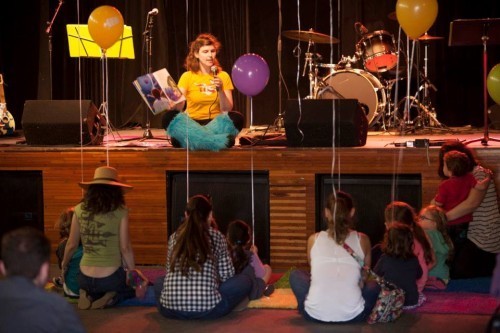
Thanks to Dawid Parus for the image.
Thanks to those years spent doing “Five Little Monkeys” and “Open, Shut Them” ad nauseam I can retain the eyeballs of most kids from 3 on up. Before that age they’re a bit wiggly. Not impossible, but you better have something better than just a reading if you want their attention.
2. You must be willing to make a fool of yourself.
Remember those days in library school where you had to conduct a mock toddler storytime for your peers, and you thought it was the most embarrassing thing you ever had to do? Baby, you had no IDEA what you were in for! Whether it’s an 18-month year old taking a bite out of your neck or a general flailing of the limbs in an effort to engage a baby, you are going to look silly.
And if you can do it wearing blue fur, all the better.
3. You must be open to a change in plans.
You’re going to have a preschool storytime on a Saturday morning but what walks in the door instead? Tiny tots. Suddenly out goes the Fortunately by Remy Charlip and in comes The Noisy Counting Book by Susan Schade. And it is the exact same thing when you perform your own book. Though library storytimes have on distinct advantage over those performed by authors. When you’re in a library, you don’t have to worry about an all adult audience. THAT is an interesting situation.
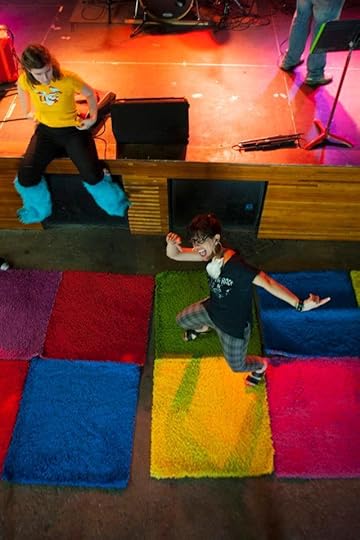
Thanks to Dawid Parus for the image.
4. You must be able to handle any question, no matter how weird.
That’s a reference desk skill, pure and simple. You know when you’re sitting at the desk and a three-year-old comes up asking for, “The one with the baker and his wife and Jesus and the lady with the white hat and she is NOT a pilgrim” and after some additional questions you determine that in spite of all logical evidence to the contrary they’re asking for Strega Nona? That exact same exchange happens when you’re a children’s author. You open the book and a kid points out that they own a dog. There is no dog in the book. You did not mention a dog in your talk. Dogs have nothing to do with anything, but that’s what the kid is saying so you just have to go with it.
Long story short, the best training ground for not just picture book authorship but ANY job is children’s librarianship. I bet you could apply additional skills to additional problems. It’s just that flexible.
May 20, 2013
Press Release Fun: 2013 Carle Honors Honorees Announced
The Eric Carle Museum of Picture Book Art
Announces 2013 Carle Honors Honorees
Eighth annual awards fête the individuals and organizations that provide creative vision and long-term dedication to the world of picture books
(Amherst, MA –May 20, 2013) The Eric Carle Museum of Picture Book Art is pleased to announce the 2013 Carle Honors honorees to be celebrated at Guastavino’s in New York City on Thursday, September 26, 2013. The eighth annual benefit will pay tribute to the talented people who have made the picture book such a vibrant and impactful art form in America. This year, the Carle Honors will honor the following selection of distinguished luminaries in four categories:
Artist : Chris Van Allsburg
In the Artist category, The Carle will recognize Chris Van Allsburg, the groundbreaking artist and author and winner of two Caldecott Medals for Jumanji and The Polar Express.
Angel : Lynda Johnson Robb and Carol Rasco
In the Angel category, The Carle will recognize Lynda Johnson Robb and Carol Rasco for their tireless advocacy for children’s literacy. Robb is Reading Is Fundamental’s Founding Board Member and Chairman Emeritus, and Rasco its President & CEO.
Mentor : Phyllis Fogelman Baker
In the Mentor category, The Carle will recognize Phyllis Fogelman Baker, an influential editor and publisher dedicated to bringing fresh voices and exceptional books to children.
Bridge : Barbara Bader
In the Bridge category, The Carle will recognize Barbara Bader, author of the seminal scholarly book, American Picturebooks from Noah’s Ark to The Beast Within.
The Carle Honors celebrates individuals and organizations that bring creative vision and long-term dedication to picture books and the many ways they open children’s minds to art and literacy. The awards are selected each year by a committee chaired by children’s literature historian and critic Leonard S. Marcus, who was central to the founding of the Honors. The committee recognizes four distinct awards: Artist, for lifelong innovation in the field; Angel, whose generous financial support is crucial to making picture book art exhibitions, education programs, and related projects a reality; Mentor, editors, designers, and educators who champion the art form; and Bridge, individuals who have found inspired ways to bring the art of the picture book to larger audiences through work in other fields.
The Carle Honors is a critical fundraiser for the The Eric Carle Museum of Picture Book Art, helping to support the Museum’s mission of inspiring of love of art and reading through picture books. For ticket and sponsorship information, including the ability to sponsor an educator to attend the gala, please contact Rebecca Miller Goggins, Director of Development at 413-658-1118 or rebeccag@carlemuseum.org.
About The Eric Carle Museum of Picture Book Art:
The mission for The Eric Carle Museum of Picture Book Art, a non-profit organization in Amherst, MA, is to inspire a love of art and reading. The only full-scale museum of its kind in the United States, The Carle collects, preserves, presents, and celebrates picture books and picture book illustrations from around the world. In addition to underscoring the cultural, historical, and artistic significance of picture books and their art form, The Carle offers educational programs that provide a foundation for arts integration and literacy.
Eric and Barbara Carle founded the Museum in November 2002. Eric Carle is the renowned author and illustrator of more than 70 books, including the 1969 classic, The Very Hungry Caterpillar. Since opening, the 40,000-foot facility has served more than half a million visitors, including 30,000 schoolchildren. Its extensive resources include a collection of more than 10,000 picture book illustrations, three art galleries, an art studio, a theater, picture book and scholarly libraries, and educational programs for families, scholars, educators, and schoolchildren. Educational offerings include professional training for educators around the country. Museum hours are Tuesday through Friday 10 a.m. to 4 p.m., Saturday 10 a.m. to 5 p.m., and Sunday 12 noon to 5 p.m. with special extended summer hours. Admission is $9 for adults, $6 for children under 18, and $22.50 for a family of four. For further information and directions, call 413-658-1100 or visit the Museum’s website at www.carlemuseum.org.
For media inquiries, additional press information and photo requests, please contact Sandy Soderberg at Sandys@carlemuseum.org/413-658-1105 or Alexandra Pearson at Alexandra@rosengrouppr.com/646-695-7048.
Butterfly from The Very Hungry Caterpillar copyright 1969 and 1987 by Eric Carle.
###
Sandy Soderberg
Marketing Manager
The Eric Carle Museum of Picture Book Art
125 West Bay Road
Amherst, MA 01002
BEA One Stop Shopping: What to See and Do That’s YA & JUV
I can’t take full credit for today’s post since it was my ineffable co-worker Alison Hendon who took the time to cull together all the stuff at this month’s upcoming Book Expo that is children and YA book related. If you have any interest at all in attending but you’re not quite sure what there is to do, here’s a lovely schedule of events:
BEA 2013
THURSDAY, MAY 30
Getting Kids Reading 9:30-10:20 1E12/1E13
YA Editors Buzz 10-10:50 1E14/1E15
Library Family Feud 10-11:50 1E11
Journey of a YA Book 11-11:50 1E16
Future of Ebooks 2-2:50 1E07
SF/Fantasy 3-3:30 Uptown Stage
Ebooks from Libraries 3:30-4:20 1E10
The New Graphic Novel 4-4:45 Uptown Stage
FRIDAY MAY 31
YA Author Buzz 10-10:30 Uptown Stage
Out of this World Pageturners 11-11:30 Uptown Stage
Middle Grade Editors Buzz 11-11:50 1E12/1E13
Writing Genre for Boys 12:12:30 Uptown Stage
Middle Grade Authors Buzz 1-1:30 Uptown Stage
Picture Book Powerhouses 2-2:30 Uptown Stage
Betsy Bird signs Giant Dance Party 3:00 Table 8
Realistic Fiction YA 3:30 Uptown Stage
Librarian Shout and Share 3:30-5 1E11
Kate DiCamillo/Cynthia Voigt 4-4:50 Uptown Stage
SATURDAY JUNE 1
Adult Crossover/YA 11-11:30 Midtown Stage
Sci Fi / Fantasy Writers 12-12:30 Midtown Stage
Note that I have helpfully highlighted the most important events *cough cough* for your attending convenience. One of those is the somewhat confusing “Family Feud”. Essentially, if you’ve ever wanted to watch me trash talk John Rocco, now’s your chance. The official description is below.
Authors and Librarians, Get Ready for the Feud….Library Family Feud! ™10:00 am – 11:50 am
Room 1E11Start out your convention RIGHT with a little sparring of smart wits between a team of librarians and authors who go at it Family Feud ™ style. Featuring the nation’s smartest, toughest, and humor filled writers and librarians across the country! Hosted by AAP Library Committee Chair Chris Vaccari, Director, Sterling (aka…Quizmaster Chris…the industry’s own Richard Dawson). Speakers (er, game show contestants) revealed here:
LIBRARIAN FAMILY: Christopher Platt, New York Public Library; Betsy Bird, New York Public Library; Erin Shea, Darien Library; Elissa Miller, DC Public Library and Jamie Watson, Baltimore County Public Library.
AUTHOR FAMILY: Simon Doonan, author of The Asylum: A Collage of Couture Reminiscences (Penguin/Blue Rider Press); Stephanie Evanovich, author of Big Girl Panties (HarperCollins/William Morrow); John Rocco, author of Super Hair-O and the Barber of Doom (Disney-Hyperion); Jill Shalvis, author of It Had To Be You (Hachette/Grand Central); Obert Skye, author of Pinocula (Macmillan Children’s). A donation will be made to the winning (and losing) team’s charity of choice!
Thems authors be going down!
May 18, 2013
Review of the Day: Hold Fast by Blue Balliett
 Hold Fast
Hold Fast
By Blue Balliett
Scholastic
$17.99
ISBN: 978-0545299886
Ages 9-12
I honestly don’t think you can be a reviewer without being honest about your own personal prejudices first. When I pick up a book for children I have to cut through a thick swath of issues infecting my brain that may have little to nothing to do with the book in hand. Maybe I was forced to read Stuart Little when I was a child and that’s why I’ve never liked animal fantasies. Maybe a poorly constructed sports novel burned a small hole in my soul and that’s why this particular baseball novel isn’t ringing true to me. You have to own up right from the start to what makes you tick as a reviewer. So that’s what I’m going to do with Blue Balliett’s book Hold Fast. Here are the facts of the matter. I have read two other books of Ms. Balliett’s in the past and they were not to my taste. That’s fact number one. Fact number two is that when I am disappointed in a book it makes me even more critical of the title than would be normal for me. So read on if you like, but bear in mind that these two facts are at the forefront of this very review. I read Hold Fast by Blue Balliett. I did not much care for it.
Sum, Dash, Early and Jubie. Four people in a single family. Take away one of them? Disaster. That’s how Early feels when her beloved father Dash disappears one night on his way home from the library. The police are willing to believe that he’s just another deadbeat dad but Early knows better. Surely his disappearance has something to do with a side job he got at the library. And what’s the connection to those scary men who threatened her family, forcing them to seek help in one of Chicago’s many shelters? Though she’s just a kid, Early is determined to solve the mystery for the sake of her little brother Jubie, her seriously depressed mom Sum, and the father who might be out there needing her help.
You might wonder why I would suck on such bitter disappointment with this book right from the get-go when, as I’ve already stated, it wasn’t as if my expectations were high to begin with. But you see my expectations were high. Not because of the author necessarily, but because of the description of the plot. I work in the ultimate urban library system: New York City. I see middle grade books for kids waltz through my library’s doors every single solitary day. Sheer hoards of books are published for children in a given year. Now recount for me all the titles you can think of off the top of your head that deal with the shelter system. Not the foster care system (though that genre could certainly use a kick in the pants as well) but the kids and adults caught up in shelters. In all my years of librarianship I can tell you honestly that I have never read a single solitary middle grade novel, or picture book for that matter, that dared to explain, explore, or inhabit the world of shelters. The children living there might as well not exist for all that they don’t show up in books. So for Ms. Balliett to research and throw herself heart and soul into a book that dares to explore this remarkable topic is to her credit. For that alone she should be commended. And had I not read the book I could have left it at that. But I did read the book. That is where the trouble started.
I recently wrote a post on my blog decrying the lack of African-American male protagonists in middle grade novels (particularly in the publishing year 2013). Balliett’s protagonist is female, but that’s fine and dandy with me. As much as we need boys, we need girls just as much. I’ve never had a problem with an author writing about a character outside their own race. Do your research and avoid the obvious pitfalls and you’ll have my support. “Hold Fast” starts out fine in this respect. The family lives lower-income lives (in part, perhaps, due to Summer’s crippling and understandably untreated depression), just about scraping by until tragedy knocks them flat. But once they entered the shelter my hackles began to raise. With the exception of Summer and an older woman they meet in the shelter with grown children, almost every mother encountered in this book threatens her children with beatings, beltings, slaps, hits, and other forms of physical punishment. About the third time it happened I was getting worried. What precisely are we trying to say here? The rare mom who doesn’t hit her kids is either sunk in depression or gets carted off for drug possession. Is this really what we want to say about the African-American women caught in Chicago’s shelter system? I understand that such physicality occurs, but the frequency went beyond mere personality quirk to commentary. And not a commentary I necessarily want kids to read.
Then there was the small difficulty of Dash’s personality. There is a thin line between the joyous father figure character that supports his children’s hopes and dreams, inspiring them along the way, and a character that speaks almost entirely in platitudes. Dash might have been able to take a page out of the book of Ratchet’s father in This Journal Belongs to Ratchet by Nancy Cavanaugh. A fellow 2013 publication, Ratchet’s dad bears much in common with Dash. Both men have high aspirations for a better world and speak truth to power. Both enjoy wordplay. But while Ratchet’s dad speaks in platitudes on a regular basis, he has a personality above and beyond his aphorisms. More to the point, he has some major character flaws. Dash, in stark contrast, feels less like a real flesh-and-blood human and more like a stand-in for an idea. The self-made man who quotes Langston Hughes is a caricature if not reigned in continually. Dash, unfortunately, is never given any flaws except an excess of misplaced trust in his fellow man. I wanted someone real to worry about. Instead, all I had was a symbol.
That Early has a bit of a Pollyanna in her is almost a necessary character quality. When you’re so beaten down you find yourself trapped without seeing any hope in your situation, you need some kind of inner strength to carry on. She has it in droves, and mostly as a character she worked for me. There were, however, two exception to this. The first was a sequence where Early introduces the joy of reading to the other kids in the shelter. It’s an old-fashioned “reading is fun” portion of the book that didn’t feel right at all. It contained honest-to-goodness lines like, “It’s so fun, like seeing a movie with popcorn, only better, because it stays in your head as long as you want it to and then you can go back and see parts of it again!” Like an after school special had walked into what was otherwise a rather realistic novel. Then there were Early’s interrogation skills. Even a willing sense of disbelief must raise a skeptical eyebrow when a kid asking a grown person questions in conjunction with a crime can make that adult sweat profusely and quail under their directness. That one was a bit hard to buy.
What kills me is that there is so much to potentially enjoy in this book. The idea of using the definition of words as a way of finding clues? That’s fun! The section that rightly points out that it was, “as if you weren’t 100 percent human when you came into the police station on the wrong side of the front desk. If you were upset, it was unreasonable. If you had a question, it could wait. Just the fact that you were there seemed like a strike against you.” That’s good writing. And that’s what kills me. So much of this book works. What sinks it is that the parts that don’t work REALLY don’t work and the bad weighs down the good. If I can’t believe in my characters then I can’t believe in a book. My favorite character in Hold Fast ended up being the setting. In terms of a sense of place, Balliett can’t be beat. You are there. You are with her. You are trapped even as her characters are trapped. But you’re prevented from completely identifying with them. The end result is that you still end up learning a lot about the shelters and the people in them, despite the actual plot. And maybe, in a way, that’s a success that makes the whole book worth it in the end. However you chose to look at it, the bones of Hold Fast could be called strong. It’s the excess that keeps it from reaching what could have been its full potential.
May 16, 2013
Fusenews: Honest Toddlers and Awesome Amish
Along very much the same lines, I would like you to read the best book review you will read all year. Possibly all decade. If you have not experienced a Pink Me review before, they pretty much give me something to strive for. Paula knows how to zero in on the meat of a book, and acknowledge the good alongside the seriously uncomfortable. And what’s making her uncomfortable at the moment? That would be Trash Can Days by Teddy Steinkeller. If we are talking about depictions of race in books for our youth, then this is an excellent place to start the conversation. This is your required reading of the day. A billion thanks to Mary Ann for the heads up.
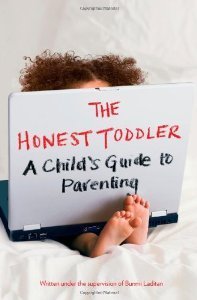 Not sure if I should be furious or relieved that the universe didn’t alert me to the fact that Honest Toddler, one of my favorite Twitter feeds, has a blog. Better still, there are children’s book reviews. Worth seeking out if only because it managed to work the phrase, “too much rim make the ride too hard” into an encapsulation of Babar.
Not sure if I should be furious or relieved that the universe didn’t alert me to the fact that Honest Toddler, one of my favorite Twitter feeds, has a blog. Better still, there are children’s book reviews. Worth seeking out if only because it managed to work the phrase, “too much rim make the ride too hard” into an encapsulation of Babar.I was so very very happy to see that the WNBA recently announced that one of its winners of the 2013 Pannell Award was none other than the delightful Bookbug Bookstore in Kalamazoo, Michigan. Bookbug recently went out of their way to create for me the greatest Giant Dance Party the world has ever known. I’m talking strobe lights, cupcakes, a smoke machine, kicky music, and an actual GIANT in the house. Derek Molitor and Joanna Parzakonis totally deserve that award. If you see them at BEA this year, give ‘em a clap on the back from me.
The site Dolce Bellezza is hosting an upcoming reading challenge in June asking folks to come up with Japanese children’s books. The comments offer more suggestions as well, in case you’re interested.
Once upon a time I used to work in the Central Children’s Room of New York Public Library in a branch located across the street from MOMA called The Donnell. Then they tore it down. Tore it down good they did. That was back in 2008 and finally they’ve announced the new library location that will be in the same space. The 53 Street Branch Designs were covered by all major New York City dailies and more so if you’re curious to see what the world’s most ultra-mod library branch looks like, observe: The New York Times The Wall Street Journal, The New York Post, The New York Daily News, The Associated Press, and NY1.
In other library news, Jay-Z was found in our archives . . . circa 1939.
The picture book to screen adaptation process is an ugly business. All the more so when the book doesn’t exactly lend itself to exploits. I swear to god if they add just ONE alien or Russian spy . . .
This just in from Kansas State University: Five Faculty Members Named Newest University Distinguished Professors. Why should you care? Because one of those five was our very own Phil Nel. He of the Nine Kinds of Pie blog, no less. Think you don’t have enough time to blog? Yeah, try being a freakin’ distinguished professor at a university. Show ‘em how it’s done, Nel!
Regarding book covers, this is how you do it people. Want to make your average everyday kid read about the Amish willingly?
Geez, that’s a smart cover. Why is this so hard for some folks to figure out? This! Do this!
Good news, folks! Dan Blank, one of my favorite folks in town, is in the business of telling authors how to do parts of their jobs better. He does these webinars that are well worth considering. In fact, on 5/22 he has a Build Your Author Platform course you might do well to check out. Just sayin’.
Rita Meade, I love you. Today is a day for me to link to bloggers unafraid to take up arms against ignorance. In this case, Rita offers a response to Michael Rosenblum’s disheartening What’s a Library? piece. His piece reminds me of the time I was seated next to an otherwise perfectly nice hedge fund manager who had a hard time contemplating why libraries continue to exist. For him, the argument that not everything is digitized (or will be) and libraries contain out-of-print titles turned out to be my most persuasive point (like Rosenblum, he was unmoved by the not-everyone-has-internet-access argument), but it’s different for every person. In any case, Rita’s response does the heart good. We need more Ritas.
Heart still bleeding a little? This’ll sop up the mess. A heartwarming (in the truest sense) post from Kathi Appelt.
Were you listening to Ask Me Another when Lois Lowry appeared on the program? If not, she shows up at around 18:40. Thanks to Ben Collinsworth for the link.
It’s about this point that I realize that I may be the last person in our business (the children’s / YA book biz) not to mention Maureen Johnson’s remarkable Coverflip piece. You’ve probably all seen this already, but if you’re the last person in America to find it, you’re welcome.
I might have mentioned in my Neil Gaiman / Jon Klassen / Lemony Snicket post that I was at Bank Street College of Education recently to talk with some of the kiddos there about book covers. Allie Bruce, local librarian extraordinaire, was kind enough to blog about my visit as well as some of the responses from the kids. If you wanna see me showing more thigh than I really should (yes, I’m afraid that really is what I wear when I talk to 6th graders) now’s your chance. Also check out the kids’ thoughts on books seen in “a certain bookstore chain” recently.
Daily Image:
This is nice. An Austin photographer decided that rather than dress her 5-year-old up like a Disney princess she’d do something a little different and dress her up like a range of kickass women. Here’s one of the many results of the project:
Loverly. You can see more here.
Fusenews:
Along very much the same lines, I would like you to read the best book review you will read all year. Possibly all decade. If you have not experienced a Pink Me review before, they pretty much give me something to strive for. Paula knows how to zero in on the meat of a book, and acknowledge the good alongside the seriously uncomfortable. And what’s making her uncomfortable at the moment? That would be Trash Can Days by Teddy Steinkeller. If we are talking about depictions of race in books for our youth, then this is an excellent place to start the conversation. This is your required reading of the day. A billion thanks to Mary Ann for the heads up.
 Not sure if I should be furious or relieved that the universe didn’t alert me to the fact that Honest Toddler, one of my favorite Twitter feeds, has a blog. Better still, there are children’s book reviews. Worth seeking out if only because it managed to work the phrase, “too much rim make the ride too hard” into an encapsulation of Babar.
Not sure if I should be furious or relieved that the universe didn’t alert me to the fact that Honest Toddler, one of my favorite Twitter feeds, has a blog. Better still, there are children’s book reviews. Worth seeking out if only because it managed to work the phrase, “too much rim make the ride too hard” into an encapsulation of Babar.I was so very very happy to see that the WNBA recently announced that one of its winners of the 2013 Pannell Award was none other than the delightful Bookbug Bookstore in Kalamazoo, Michigan. Bookbug recently went out of their way to create for me the greatest Giant Dance Party the world has ever known. I’m talking strobe lights, cupcakes, a smoke machine, kicky music, and an actual GIANT in the house. Derek and Joanna Parzakonis totally deserve that award. If you see them at BEA this year, give ‘em a clap on the back from me.
The site Dolce Bellezza is hosting an upcoming reading challenge in June asking folks to come up with Japanese children’s books. The comments offer more suggestions as well, in case you’re interested.
Once upon a time I used to work in the Central Children’s Room of New York Public Library in a branch located across the street from MOMA called The Donnell. Then they tore it down. Tore it down good they did. That was back in 2008 and finally they’ve announced the new library location that will be in the same space. The 53 Street Branch Designs were covered by all major New York City dailies and more so if you’re curious to see what the world’s most ultra-mod library branch looks like, observe: The New York Times The Wall Street Journal, The New York Post, The New York Daily News, The Associated Press, and NY1.
In other library news, Jay-Z was found in our archives . . . circa 1939.
The picture book to screen adaptation process is an ugly business. All the more so when the book doesn’t exactly lend itself to exploits. I swear to god if they add just ONE alien or Russian spy . . .
This just in from Kansas State University: Five Faculty Members Named Newest University Distinguished Professors. Why should you care? Because one of those five was our very own Phil Nel. He of the Nine Kinds of Pie blog, no less. Think you don’t have enough time to blog? Yeah, try being a freakin’ distinguished professor at a university. Show ‘em how it’s done, Nel!
Regarding book covers, this is how you do it people. Want to make your average everyday kid read about the Amish willingly?
Geez, that’s a smart cover. Why is this so hard for some folks to figure out? This! Do this!
Good news, folks! Dan Blank, one of my favorite folks in town, is in the business of telling authors how to do parts of their jobs better. He does these webinars that are well worth considering. In fact, on 5/22 he has a Build Your Author Platform course you might do well to check out. Just sayin’.
Rita Meade, I love you. Today is a day for me to link to bloggers unafraid to take up arms against ignorance. In this case, Rita offers a response to Michael Rosenblum’s disheartening What’s a Library? piece. His piece reminds me of the time I was seated next to an otherwise perfectly nice hedge fund manager who had a hard time contemplating why libraries continue to exist. For him, the argument that not everything is digitized (or will be) and libraries contain out-of-print titles turned out to be my most persuasive point (like Rosenblum, he was unmoved by the not-everyone-has-internet-access argument), but it’s different for every person. In any case, Rita’s response does the heart good. We need more Ritas.
Heart still bleeding a little? This’ll sop up the mess. A heartwarming (in the truest sense) post from Kathi Appelt.
Were you listening to Ask Me Another when Lois Lowry appeared on the program? If not, she shows up at around 18:40. Thanks to Ben Collinsworth for the link.
It’s about this point that I realize that I may be the last person in our business (the children’s / YA book biz) not to mention Maureen Johnson’s remarkable Coverflip piece. You’ve probably all seen this already, but if you’re the last person in America to find it, you’re welcome.
I might have mentioned in my Neil Gaiman / Jon Klassen / Lemony Snicket post that I was at Bank Street College of Education recently to talk with some of the kiddos there about book covers. Allie Brosh, local librarian extraordinaire, was kind enough to blog about my visit as well as some of the responses from the kids. If you wanna see me showing more thigh than I really should (yes, I’m afraid that really is what I wear when I talk to 6th graders) now’s your chance. Also check out the kids’ thoughts on books seen in “a certain bookstore chain” recently.
Daily Image:
This is nice. An Austin photographer decided that rather than dress her 5-year-old up like a Disney princess she’d do something a little different and dress her up like a range of kickass women. Here’s one of the many results of the project:
Loverly. You can see more here.
May 14, 2013
Press Release Fun: 2014 Hans Christian Andersen Award Nominees Released
Swoon.
IBBY Announces the 2014 Hans Christian Andersen Award Jury and Nominees
The Hans Christian Andersen Award is the highest international distinction given to authors and illustrators of children’s books. Given every other year by IBBY, the Hans Christian Andersen Awards recognize lifelong achievement and are given to an author and an illustrator whose complete works have made an important, lasting contribution to children’s literature.
The 2014 Jury, selected by IBBY’s Executive Committee from nominations made by its national sections, comprises the following ten distinguished members from across the globe. Jury President María Jesús Gil (Madrid, Spain) will lead the Jury to select the winners of the 2014 Hans Christian Andersen awards.
Anastasia Arkhipova Illustrator, chair of the board of the Association of Moscow Book Illustrators and Designers, Moscow, Russia.
Fanuel Hanan Diaz Editor, author and researcher, Caracas, Venezuela.
Sabine Fuchs University lecturer in children’s literature, Graz, Austria.
Sang-Wook Kim Professor in children’s literature at the Chuncheon National University of Education, Seoul, Korea.
Enrique Pérez Díaz Author and publisher, Havana, Cuba.
Deborah Soria Book-seller and promoter of children’s literature, Rome, Italy.
Susan M. Stan Professor of children’s literature at the Central Michigan University, USA.
Sahar Tarhandeh Independent researcher in children’s literature, freelance graphic designer and art director, Tehran, Iran.
Erik Titusson Publisher and former Director of the ALMA, Stockholm, Sweden.
Ayfer Gürdal Ünal Writer, critic, and lecturer at the Bhosphorous University, Istanbul, Turkey.
Former IBBY Vice President Elda Nogueira (Rio de Janeiro, Brazil) and IBBY Executive Director Liz Page are ex officio Jury members.
The following nominees have been submitted for the 2014 Hans Christian Andersen Awards by the National Sections of IBBY. For the 2014 Awards 29 authors and 31 illustrators have been nominated from 34 countries.
Argentina: author María Cristina Ramos; illustrator Isol
Australia; author Nadia Wheatley; illustrator Ron Brooks
Austria: author Renate Welsh; illustrator Linda Wolfsgruber
Azerbaijan: author Sevinj Nurugizi
Belgium: author Frank Andriat; illustrator Carll Cneut
Brazil: author Joel Rufino dos Santos; illustrator Roger Mello
Canada: author Kenneth Oppel; illustrator Philippe Béha
China: author Hongying Yang; illustrator Liang Xiong
Croatia: illustrator Svjetlan Junaković
Denmark: author Lene Kaaberbøl; illustrator Charlotte Pardi
Estonia: author Aino Pervik
Finland: author Kirsi Kunnas; illustrator Pekka Vuori
France: author Jean-Claude Mourlevat; illustrator François Place
Germany: author Mirjam Pressler; illustrator Rotraut Susanne Berner
Greece: author Sofia Madouvalou; illustrator Daniela Stamatiadi
Iran: author Houshang Moradi Kermani
Ireland: author Eoin Colfer; illustrator PJ Lynch
Italy: author Bianca Pitzorno; illustrator Fabian Negrin
Japan: author Nahoko Uehashi; illustrator Ken Katayama
Republic of Korea: author Jin-Kyung Kim; illustrator Byoung-Ho Han
Latvia: illustrator Reinis Pētersons
Netherlands: author Ted van Lieshout; illustrator Marit Törnqvist
Norway: author Bjørn Sortland; illustrator Øyvind Torseter
Portugal: author António Torrado; illustrator Teresa Lima
Russia: author Vladislav Krapivin; illustrator Igor Oleinikov
Serbia: author Ljubivoje Ršumović; illustrator Dobrosav Živković
Slovakia: author Daniel Hevier; illustrator Peter Uchnár
Slovenia: author Polonca Kovač; illustrator Alenka Sottler
Spain: illustrator Javier Zabala
Sweden: illustrator Eva Lindström
Switzerland: illustrator Albertine
Turkey: author Serpil Ural; illustrator Saadet Ceylan
UK: author Jacqueline Wilson; illustrator John Burningham
USA: author Jacqueline Woodson; illustrator Bryan Collier
The Jury President will guide the judging process and preside at the jury meeting 15-16 March 2014. The shortlist will be disseminated immediately following the Jury meeting and the winners will be announced at the IBBY Press Conference at the Bologna Children’s Book Fair on Monday, 24 March 2014.


